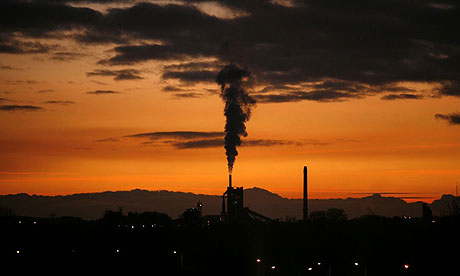Revealed: The cement that eats carbon dioxide

Cement works in Clitheroe, Lancashire. Cement accounts for 5% of the world's CO2 emissions - more than aviation. Photograph: Christopher Thomond.
Cement, a vast source of planet-warming carbon dioxide, could be transformed into a means of stripping the greenhouse gas from the atmosphere, thanks to an innovation from British engineers.
The new environmentally friendly formulation means the cement industry could change from being a "significant emitter to a significant absorber of CO2," says Nikolaos Vlasopoulos, chief scientist at London-based Novacem, whose invention has garnered support and funding from industry and environmentalists.
The new cement, which uses a different raw material, certainly has a vast potential market. Making the 2 billion tonnes of cement used globally every year pumps out 5% of the world's CO2 emissions -- more than the entire aviation industry. And the long-term trends are upwards: a recent report by the French bank Credit Agricole estimated that, by 2020, demand for cement will increase by 50% compared to today.
Making traditional cement results in greenhouse gas emissions from two sources: it requires intense heat, and so a lot of energy to heat up the ovens that cook the raw material, such as limestone. That then releases further CO2 as it burns. But, until now, no one has found a large-scale way to tackle this fundamental problem.
Novacem's cement, based on magnesium silicates, not only requires much less heating, it also absorbs large amounts of CO2 as it hardens, making it carbon negative. Set up by Vlasopoulos and his colleagues at Imperial College London, Novacem has already attracted the attention of major construction companies such as Rio Tinto Minerals, WSP Group and Laing O'Rourke, and investors including the Carbon Trust.
The company has just started a £1.5m project funded by the government-backed Technology Strategy Board to build a pilot plant. If all goes well, Vlasopoulos expects to have Novacem products on the market within five years.
Jonathan Essex, a civil engineer at the building consultancy Bioregional who also sits on the environment and sustainability panel for the Institution of Civil Engineers, welcomed Novacem's ideas to tackle the carbon impact of cement. "In the UK the climate bill commits us to reduce CO2 emissions, and every sector should play its part. The construction industry needs to take greater responsibility for its own environmental impact." Essex said that, if Novacem can make their cement at a competitive price, the next step could be to take even more CO2 emissions out of the process by using renewable energy to fire the furnaces.
According to Novacem, its product can absorb, over its lifecycle, around 0.6 tonnes of CO2 per tonne of cement. This compares to carbon emissions of about 0.4 tonnes per of standard cement. "From that point of view, it's attractive," said Rachael Nutter, head of business incubators at the Carbon Trust. "The real challenge is what is the supply chain, who do you need to partner with to take it to market? The million-dollar question is what are the applications of it? If it ends up as decorative applications such as floor tiles, it's quite interesting but not as much as if you get into load-bearing structural stuff."
Previous attempts to make cement greener have included adding more aggregate to a concrete mixture, thereby using less cement. But this still does not tackle the problem of the carbon emissions from making the cement in the first place. Other systems use polymers in the mix, but none have yet made a significant impact on the market.
A spokesperson for the British Cement Association expressed a sceptical note, saying that though there was much ongoing laboratory work on new types of cement, there were also problems. "The reality is that the geological availability, and global distribution, of suitable natural resources, coupled with the extensive validation needed to confirm fitness-for-purpose, make it highly unlikely that these cements will a be realistic alternative for volume building."
Vlasopoulos responded that magnesium silicates are abundant worldwide, with 10,000 billion tonnes available, according to some estimates. "In addition, the production process of our cement is of a chemical nature, which means it can also utilise various industrial byproducts containing magnesium in its composition." He is confident the material will be strong enough for use in buildings but acknowledged that getting licenses to use it will take several years of testing.
Explainer: Ecofriendly vs. traditional cement
Standard cement, also known as Portland cement, is made by heating limestone or clay to around 1,500 C. The processing of the ingredients releases 0.8 tonnes of CO2 per tonne of cement. When it is eventually mixed with water for use in a building, each tonne of cement can absorb up to 0.4 tonnes of CO2, but that still leaves an overall carbon footprint per tonne of 0.4 tonnes.
Novacem's cement, which has a patent pending on it, uses magnesium silicates which emit no CO2 when heated. Its production process also runs at much lower temperatures -- around 650 C. This leads to total CO2 emissions of up to 0.5 tonnes of CO2 per tonne of cement produced. But the Novacem cement formula absorb far more CO2 as it hardens -- about 1.1 tonnes. So the overall carbon footprint is negative -- i.e., the cement removes 0.6 tonnes of CO2 per tonne used.
Link to article: http://www.guardian.co.uk/environment/2008/dec/31/cement-carbon-emissions







No comments:
Post a Comment